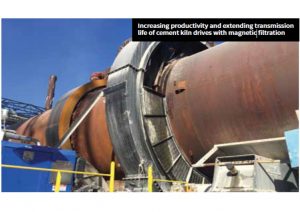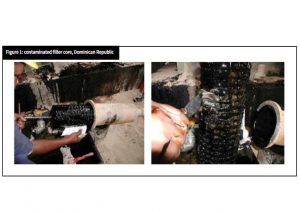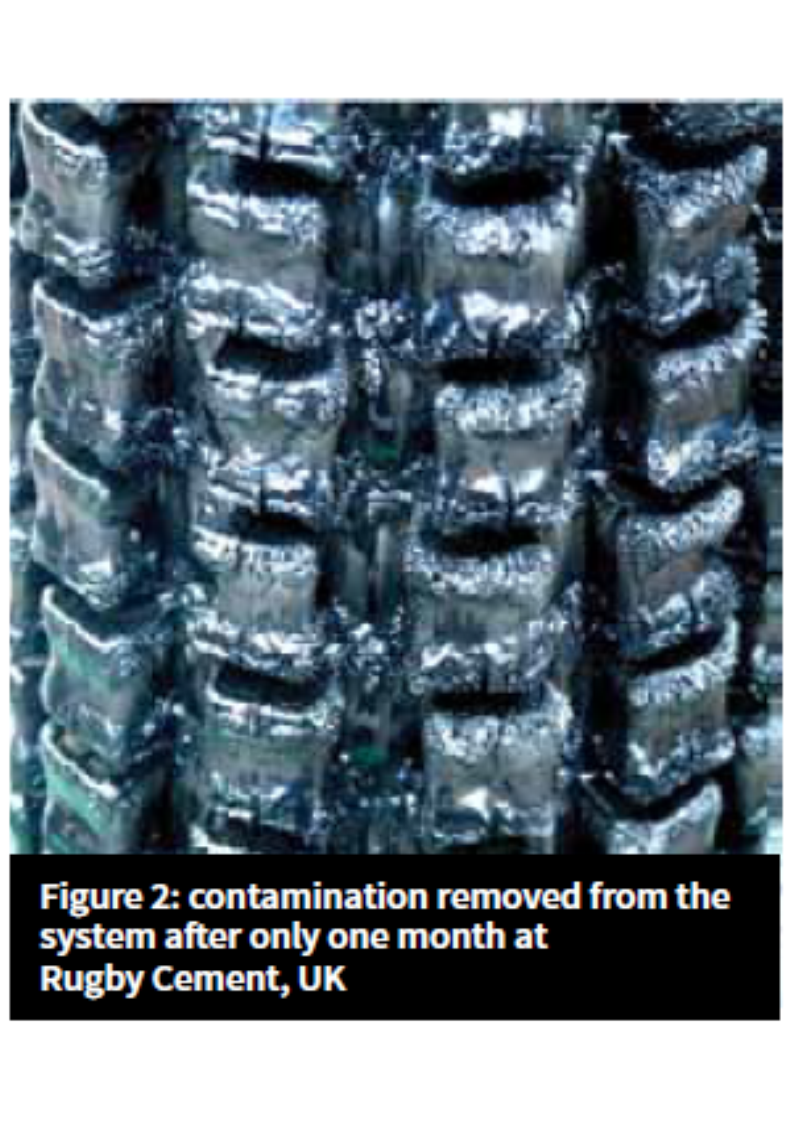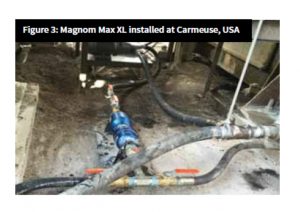Magnetic Filtration
The build-up of micrometre-sized ferrous particles in lubricating fluid can result in the heavy wear and subsequent failure of cement kiln drive transmissions.
The application of magnetic filtration technology has proven to not only rectify this issue but can prevent build-up occurring, thereby increasing productivity and extending transmission life.
The build-up of ferrous contaminant in critical lubricating fluids can result
in heavy wear and the failure of cement kiln drive transmissions. The subsequent
blocking of oil/lubricant spray nozzles with the ferrous contaminant only makes the
attrition worse. The system can be starved of its lubricating oil supply, and/or suffer
from super-hard and sharp, micrometresized particles of steel passing between
critical working surfaces, in this case the gears.
No matter how good the lubricant, if it cannot be kept free from this severely
damaging contaminant, it is unable to do its job. The affected particles breech the
protective oil film and cause boundary layer rupture of the lubricant, resulting
in direct metal-to-metal contact. The subsequent system attrition can lead to
more oil changes being needed, as well as increased downtime and maintenance
costs, and eventually premature system failure.
Factoring in the cost of replacement parts (in this case the transmissions), as
well as engineering/maintenance time to replace the failed units, frequent oil
changes and premature preventative maintenance activities (in a vain attempt
to improve the cleanliness and condition of the system), the cost of rectifying this now
preventable issue is disproportionately huge. With the overall cost typically far
greater than that of the failed component, the ultimate cost lies in system downtime
and lost production.
The Magnom solution
To prevent this problem, UK-based
Magnom has developed a solution that
uses a specially-designed magnetic filter/trap.
The Magnom technology is highly efficient (single pass) down to submicrometre
levels, thus protecting any downstream components from the damaging steel contamination.
Importantly, the Magnom Magnetic Oil Module also retains the captured
contaminant in specially-designed traps to prevent the contaminant being washed off and reintroduced into the fluid flow.
Other benefits include:
• increased production availability, ie more up-time
• reduced maintenance costs and engineering resources
• lower component and transmission system replacement costs
• less lubricant usage
• increase in oil life
• pay-back immediate to within four weeks.
Benefits over conventional filter media:-
When the major source of damaging contamination in a system is ferrous
material, typically of a smaller size than the rating of a conventional filter, the
Magnom magnetic filter offers a number of advantages.
Conventional media filter needs replacing on a regular basis and restricts
the flow of the highly-viscous lubricating oils. Media filters have not only proven
incapable of solving the historic system problems of these transmissions, they also
risk the condition of a system further with restricted oil supply.
On the other hand, the Magnom solution holds up to 40x the contaminant
of conventional filters (size for size), and is non-restrictive and cleanable/re-usable.
Cement industry applications Magnom’s technology has been applied
to many customers within the cement industry, as well as in a myriad of
other market applications from power generation to Ferrari Formula One cars.
In terms of the cement industry, the filtration technology has been used
to clean highly-viscous lubricating fluids in cement kiln drive transmissions, to
protect highly-stressed transmissions running 24/7, and to extend
production life while reducing maintenance and repair costs.
Figures 1 and 2 depict
How the large build-ups of ferrous contaminant is
removed and held, from these critical systems at cement plants
in the Dominican Republic and the UK, respectively.
Figure 3 shows :-
The Magnom Max XL installed at a Carmeuse lime plant in the USA.
From reactive to maintenance mode
Typically when a Magnom unit is installed into a system experiencing issues, the
job in hand is to purge the system of large quantities of historic contaminant
circulating within it.
Once this historic threat is removed, the Magnom is effectively in ‘maintenance
mode’, ie removing contamination from the system as it is generated, thus preventing
build-up and ensuring the lubricating oil is able to do its job.
Fitted into a new system, the Magnom units are able to maintain oil cleanliness
and system health from the start, immediately delivering benefits for the customer.
Optimum oil performance
The removal of very small super-hard and sharp aggressive contaminants from oils
breaks the chain reaction of wear caused by their re-circulation within the system,
enabling the valuable oil in the system to perform at its optimum.
Extended availability of the transmissions to help maintain continuous
production is the main driving force behind producers choosing to adopt Magnom’s magnetic filtration.
Moreover, the technology is nowfitted as an OEM standard on cement
plant installations supplied by a leadingEuropean cement plant engineering
company.
The installation – Monitoring & Reporting findings from the Dominican Republic cement plant was facilitated by MOBIL OIL,
Link to Original ICR International article ;-
https://magnom.com/wp-content/uploads/2017/10/Full-ICR-article.pdf



